Situated in the east of Iran, Kerman is Iran’s largest province, amounting to 11% of the country’s total land mass. Home of the famous Lut Desert, Kerman is a little off the beaten track, but for those who want to explore somewhere different, be sure to pencil it in.
When I visited Kerman, we drove into the region from Hormozgan, the neighbouring province to the south. As you enter Kerman you can distinctly feel the change of terrain. Set on a high elevated plain, the desert stretches out to bare mountains on the horizon in every direction. Renowned among Iranians as being big opium smokers, Kerman locals lived up to their name immediately as wafts of opium filled my lungs at the roadside rest stop just outside of Sirjan.
As well as being the name of the province, Kerman is also the name of the major city in the area. Kerman city is situated about 370 kilometers east of Yazd or a 1-hour flight from Tehran.
Thinking about including Kerman in your Iranian itinerary? Read on for the full low down on when to go, where to stay and what to see. If you need a hand planning your trip, contact one of 1stQuest’s expert travel consultants today.
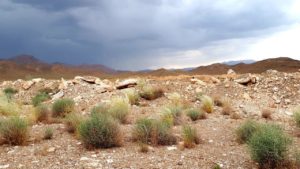
Desertscape of Kerman province
Tip 1: The best time to visit Kerman
Kerman city has the average high temperature in January of 11.8° C, and an average low of -4.0° C. In July the average maximum and minimum are 35.5° C and 17° C, respectively.
Southern parts of the province, such as the city of Bam, have a hotter, more humid climate year round.
As is the case across most of Iran, the most comfortable time to travel is spring and autumn. Summer days get hot but if you ask me, the warm breezy summer nights is when Iranian cities really come alive. Almost all accommodation options have air conditioning and central heating, so you’ll sleep well regardless of the weather outside. you can book Kerman hotels easily through 1stQuest.
Tip 2: Where to go – the best spots in Kerman
Travelers can easily spend a few days in Kerman province visiting the key sites and the notorious Kaluts in the Lut Desert.
Kerman city
As the name might suggest, Kerman is the biggest city in the province with approximately 600,000 occupants. Often described as the ugly sister to Yazd and Isfahan, visitors will notice Kerman is comparatively smaller and shabbier. With that said, I found the locals to be super friendly and less accustomed to international tourists, which made for a more genuine experience.
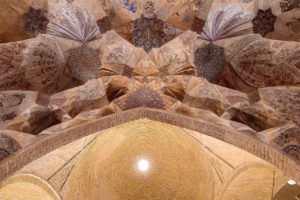
Look up and admire the complexity and perfection of the roof at the Ganj-Ali Khan bathhouse, Kerman. Photo credit: Unknown, Wikicommons.
The Ganj-Ali Khan complex is a must see for all tourists. Comprising of several caravansaries, a mosque, three bazaars and a bathhouse, this complex was built by Governor Ganj-Ali Khan almost 500 years ago.
The bathhouse is considered the finest architectural construct of the complex. The ceiling was originally made from fine cut marble that filtered the outside light, however nowadays this has been replaced with replica glass.
The bathhouse is fed by a qanat (underground waterway similar to an aqua duct) that was carved by Ganj-Ali Khan himself. The water flows into a cistern that has a 2 million liter capacity.
Bam
Bam is about a 2-hour drive south of Kerman. Celebrated for its ancient fortress, Bam is a sweet place to visit for a day.
The Arg-e-Bam is a mud-brick citadel dating back to 600 BC. The Bam Castle is included on the UNESCO World Heritage List and every visitor can understand why. Perpetually being restored (and significantly set back during Bam’s 2003 earthquake) the Arg-e-Bam is an amazing site that is remarkable condition given its age.
You can book Govashir hotel Kerman easily through 1stQuest.

Over 2,500 years old, the Arg e Bam stands tall in Bam, Kerman, Iran.
The Kaluts of the Lut Desert
The Lut Desert is actually the hottest place on earth. With soaring temperatures and wild landscapes you’ll remember this place for the rest of your life. Kalouts (or yardangs) are alien, rock-like protuberances created from 1000s of years of wind erosion and only form in the world’s driest deserts and on Mars!
Experience trekking the desert and marvel at the Kalouts over two days on Kerman private tour. Your tour will begin and end in Kerman city. Guided by a local, you can get an insight into local lifestyles and taste delicious homemade foods. For more information go to 1stQuest.com.
Shazdeh Garden, Mahan
Renowned for being perfect in every season, Shazdeh Garden in the village on Mahan is well worth the 30-minute drive from Kerman city. This terraced garden is the epitome of an oasis in the desert. Fed by a series of wells coming from the nearby mountains, the garden has been sustainably irrigated since it was built in 1850.
While you are in Mahan, you can visit the tomb of Shah Nematollah Vali, a 15th-century Persian mystic and poet. Built and added to over the centuries following his death, the shrine is is surrounded by courtyards, ponds, and beautiful mosaic tiles. Before his death, Shah Nematollah Vali would meditate and on this site. Locals believe that this is a place of power and healing.
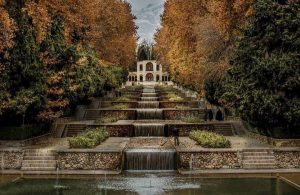
Shazdeh Garden, Mahan, Kerman, Iran
Tip 3: What to buy – Kerman local specialties
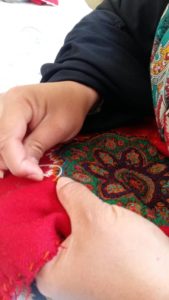
The embroidery art of Patteh is native to Kerman. Photo credit: MT467, Wikicommons.
Marco Polo passed through Kerman in the 13th century and wrote about the impeccable embroidery crafts (patteh and termeh) he observed in the region. Of Iran’s $600 million carpet export industry, Kerman plays a significant role with large factories and small cooperatives operating throughout the province producing psychedelic patterned rugs.
For a full run-down on what to buy, read: Do not leave Iran without Persian Souvenirs.
Other famed goods include pistachios, almonds, and date which all grow outstandingly well in the climate. Cumin is also a local Kerman specialty with the common Persian expression, “carrying cumin to Kerman” which is akin to “taking owls to Athens” or “carrying coal to Newcastle”.
Shawls and other cotton clothing are more recent industries in Kerman, only coming about in the last 300 years or so. Unfortunately, most of the good stuff gets exported to Egypt but those who look will find lux linen and kinds of cotton in Kerman for amazing prices.
Tip 4: Where to stay
Kerman and surrounding areas offer travelers a variety of accommodation options. My top pics are:
- Pars Hotel, Kerman– five-star comfort in Kerman city center, consistently good ratings, quite modern and spacious.
- Golden Days Guest House, Kerman– this traditional style house was converted into a guest house in 2017. Golden Days is a cute and well-priced option.
- Eyvan Hotel, Mahan– a boutique hotel in the village of Mahan with tasteful Persian architecture and its own private garden.
Browse all Kerman hotels on 1stQuest.
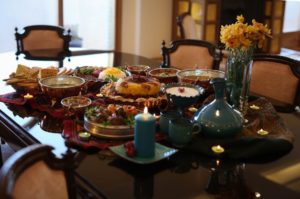
Traditional Iranian spread served at the Golden Days Guest House in Kerman
Tip 5: Where to eat – try local food
- Hamam-e Vakil Chaykhaneh Teahouse is a converted subterranean bathhouse serving simple Iranian foods and hot and cold drinks. Quite touristy but a lovely place to relax and escape the sun!
- Max Restaurant serves traditional foods and pizza. Located in central Kerman, this place lacks a little in decor but is a reliable and well-priced option for lunch or dinner.
- Keykhosro Restaurant & Coffeeshop is a great place to try local Kerman dishes and reportedly has the best coffee in Kerman. You can sit out in the garden and enjoy the ambiance of this old-style Persian home.
For more on Iranian food, check out: The most delicious Iranian cuisine should not be missed…
Tip 6: Tourist visa – apply for a visa in advance
All incoming tourists to Iran will need to obtain a tourist visa. Usually granted for a period of 30 days, visas are issued on arrival at some Iranian airports (such at Tehran’s Imam Khomeini International Airport) or visitors can apply in advance for a visa through a provider such as 1stQuest.
Applying in advance reduces your risk of rejection and disappointment. From 19 EUR 1stQuest will handle your Iran visa application for you.
